
Selina Thompson is an artist and performer based in Leeds. Her work is playful, participatory and intimate, focused on the politics of identity, and how this defines our bodies, lives and environments. She has made work for pubs, cafes, hairdressers, toilets, and sometimes even galleries and theatres, including Spill Festival of Performance, The National Theatre Studio, The Birmingham REP, East Street Arts and the West Yorkshire Playhouse. Selina’s critically acclaimed solo show salt. won The Stage Edinburgh Award, The Total Theatre Award for Experimentation, Innovation and Playing with Form and The Filipa Brangaca Award for Best Female Solo Performance.
salt. was adapted for BBC Four and is available to watch on BBC iPlayer
Time thinking through an idea
PC: What is theatre?
ST: Some people in a room listening to and watching a series of conversations that have been put together to hopefully make a point about life. I think that’s what theatre is.
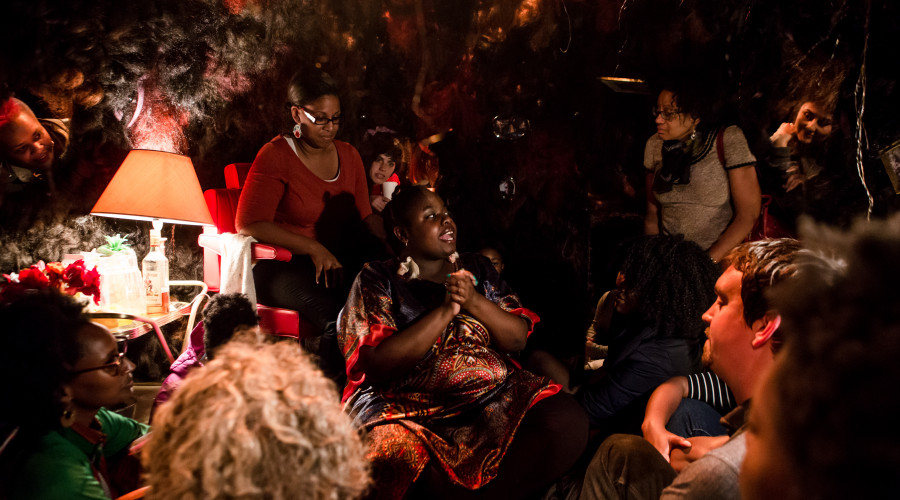
PC: How do you generate ideas for your work?
ST: Last year I was diagnosed with a form of epilepsy, which means that I sometimes hallucinate, and have been doing since I was quite small. I think they’re actually a really integral part of my process: I can zone out and imagine stuff that’s super-vivid and that often forms the key images that make the work. As soon as I know the form I want to work in, I spend time sitting and thinking through an idea.
For example, with Chewing the Fat, I’d gone to Edinburgh, I’d seen Bryony Kimmings do 7 Day Drunk and I was like: “This is wild! I can make documentary theatre, I can go off and I can research something and I can come back and I can present the research.” Obviously, it would be more difficult than that but I was absolutely overjoyed by this idea of autobiographical work with a research element. I knew that was the form that I wanted to work in first.
At that time there was something happening at uni, a girl had lost a lot of weight over the summer and it was a very well known secret that she was bulimic. If you have a load of girls in their twenties and something about body image happens it creates this series of shock waves where all of these conversations about fat and the body and food and weight-loss and dieting are happening constantly. It was driving me crazy because I felt like everybody is having every conversation except for the conversation that we need to have. I knew that Chewing the Fat had to create that conversation. I think that is what I’m always trying to do – create the conversation that needs to happen.
I then think about what the research is going to be. I started looking into all these absurd diets and it made me so angry. I remember thinking that I wanted to have this piñata that’s the shape of an apple that is full of rotting apples. What if I had a months worth of apples, three weeks worth of salad leaves, two weeks worth of chicken and a weeks worth of cheese that had all been left to rot hanging up in the drama studio? And what if I then just smashed them one by one; everyone gets rain macs maybe… if I feel like it… and we all get covered in them! I said this to the technician at the theatre and he went, “No!” I said, “Yeah, fair enough!” But that was the starting point. I knew that there needed to be this action of breaking and that there needed to be this immersion in food.
I then carry those images around in my head and I try to refine and fix them: it goes from being food everywhere to being food on my body or food seen in my body. How do we do that? Where does it need to be? You get to know your body really intimately with autobiographical work and you’re able to know the specific connotations that your body holds: for example, me on all fours eating a whole chicken looks very different from you on all fours eating a whole chicken.
I start to have a pallet of music, which was very simplistic with Chewing the Fat: the songs were about food and what I found comforting. That show is really about going from living in Birmingham in this working class, black universe and going to university where everyone is white and middle class. I wasn’t prepared for that and I didn’t have the language for it. I didn’t even realise that that was what was causing the tension for a really long time because you don’t think that way. Zora Neale Hurston writes really beautifully about how if you grow up with lots of people that are like you then you never really see yourself as other. So much of Chewing the Fat is actually about that even if I didn’t know it at the time. There were loads of songs that reminded me of home; I’d walk everywhere and listen to those and imagine those ideas. It’s like a process of dredging to start off with – I’m more sophisticated with it now.
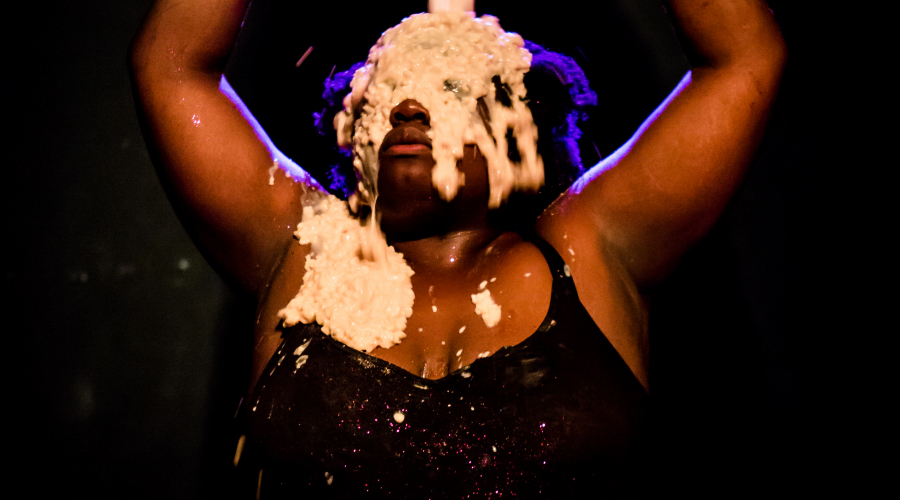
PC: How has it become more sophisticated?
ST: When I’m working on Sortition – the new play – I now know that I need to sit down once a week for half an hour with the Sortition playlist on and draw a load of ideas. That means when I come to sit down and make the work in July there’s this whole journey of all the thinking documented. It’s taken me five years to learn how to do that but I’ve got there!
Free-writing and writing lots is a big skill that came from doing the voyage for salt. Being at sea for three weeks with no internet and no TV is really boring so all there is to do is read and write. I came back from that with the discipline to be able to sit and write for three hours uninterrupted if I need to.
So I do loads of dredging but also loads of academic research: interviews with people who are experts in the topic that I’m making and reading and reading and reading!
I am always trying to have a sort of compost bed of academic information – with The Missy Elliot Project the compost bed is Afro-futurism and cyber-punk or all this really beautiful theory about cyborgs and disabled bodies in the future. The compost bed isn’t necessarily tied to what I’m going to make but having that stuff there is what gives the work an edge. It means that the work is doing more than just repeating what is well known discourse. For salt. it was a load of afro-pessimism: some really heavy, dark stuff about the end of the world and race’s role within that. For Chewing The Fat it was all about abjection and theories around pornography.
One of the most useful things that you can do, if you work in theatre or TV or film, is to take this stuff that has been made really inaccessible and make it super-accessible.
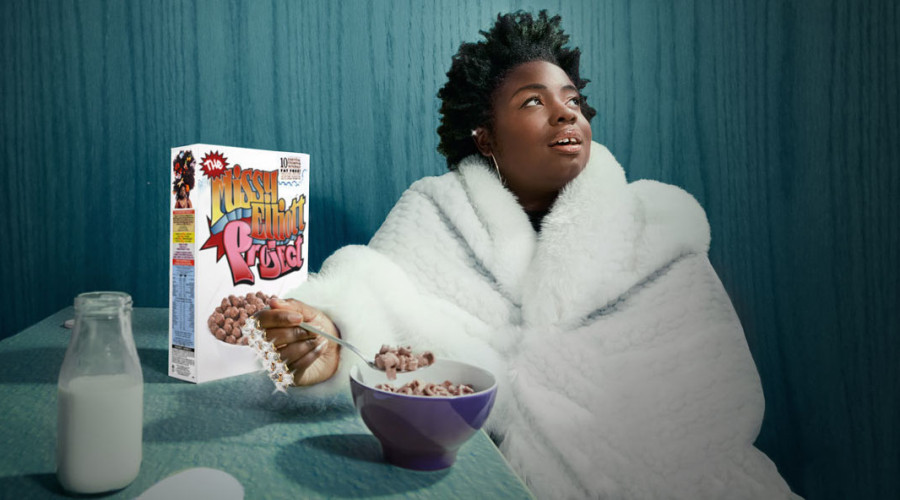
Chipping at the granite
PC: Who are your collaborators?
ST: My key collaborator is my producer, Emma Beverley. I remember Bobby Baker telling me that the Arts Council bid is a part of how you make the work: every penny of the budget: where you’re going to work; how you’re going to work; how comfortable everybody’s going to be; how much money you’ve got for chicken wire and cake mix; every single bit of that is the work. So Emma is always my first collaborator – all of the planning, all of the calibration, all of the dreaming for what impact we want our work to have we’ll do together.
Katherina Radeva, who’s the designer on salt. and is going to be the designer on Sortition. Kat also makes her own work with Two Destination Language as well as designing so I can talk her through the work and she’ll go away and she’ll draw some stuff. Kat hits the ground running, so as soon as there’s a concept she’s thinking about bits of design. I find that incredibly helpful because I’m a visual thinker – once the design ideas are there the writing will come really fast. She also storyboards the work which I really appreciate. I sometimes think working with me is like shaping a lump of granite; I can’t tell people what I want the sculpture to be, but I can tell them what I don’t want it to be and they can chip away until we have the shape we want.
Sound is always one of the last things to come for me and it’s something that I’m trying to get better at because, beyond music, I don’t think in sound a lot. I’m good with words, I can sketch out my images but it’s really difficult to communicate music and sound if you don’t make it. Tanuja Amarasuriya talked with me a lot about feelings with salt. With Nwando Ebizie it’s about how phrases and fragments of text can become music. I’m super-intimidated by sound!
Other collaborators are my production manager, Louise Gregory, who I’ve worked with for a couple years and I think I always will because I love her to pieces. Zinzi Minott has been doing the movement and choreography with The Missy Elliot Project and that’s a new relationship.
Dawn Walton was the director for salt. – I really liked working with a director. I’d like to try working with a few different directors though because I get the impression that it’s a very idiosyncratic way of working. I’d like to see what I learn as a performer and as a writer from working with lots of directors. I like how exacting they are.
PC: How does that collaborative approach fit with the solo, autobiographical nature of a lot of your work?
ST: I’m a really big believer that there’s no such thing as a solo artist. When you start out you’re like that weird Little Britain character: “I wrote the theme tune, I sang the theme tune.” As you get a little bit older, you realise there are people that can write and sing it better than you.
I need all those people because the more people you have focusing on their specific skillset the more head space there is for making the concept as strong as possible. So much of performance art is conceptual; so much of directing is conceptual in its own way actually; so much of writing for theatre is conceptual. I want as much head space as possible to get the concept as strong as possible. Also my ambition is bigger than my skill set! So I let people with the skills and the training and the knowledge and the expertise do what needs to be done to fulfil my vision. My job is to make sure my vision is as clear as possible. A big part of what those collaborators are doing is interrogating all of the dredging and the research. They force me to be explicit – chipping at the granite.
We have a shared language – with Emma that is that weird creepy, finish each other’s sentences stuff but with others it’s just a chemistry that means the shared language comes easy. I like it best when you start working with somebody who is at a similar place to where you’re at so that you’re growing together: those are the most fulfilling relationships that make the best art.
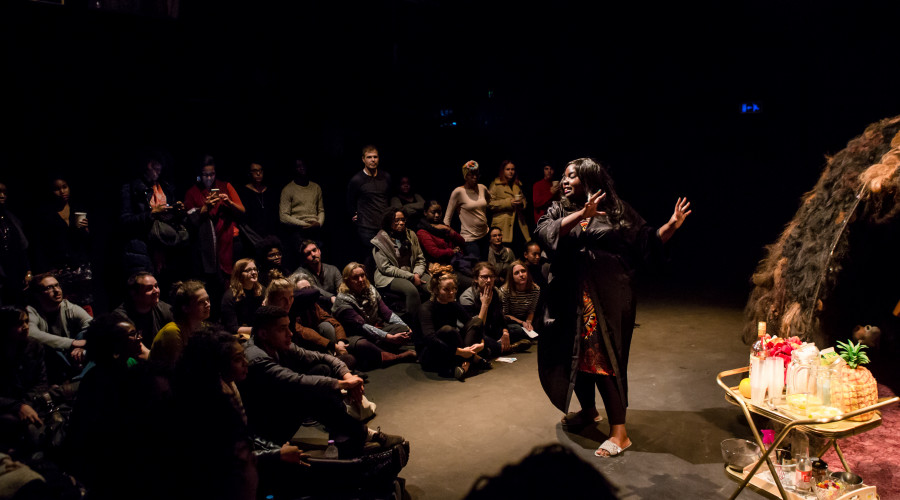
The risk works two ways
PC: How do you share risk with your audience in the form that you create?
ST: I think that the risk works two ways: theatre is not a safe space – I do not create safe spaces in the theatres that I’m in. If we’re all together in a room and I’m talking eating disorders and fat, that’s not a safe space for a lot of people. If we’re in room and I’m talking about slavery, that’s not a safe place for anybody! The audience enter that space and risk being triggered: you could be made to feel uncomfortable or made to deal with stuff you absolutely don’t want to deal with. I have enough interaction with the audience at the end of salt. and during Dark and Lovely to know that that happens.
The risk that I take, is that I am blisteringly honest. I’m much more honest in my work than I ever am in my life. The exchange is: I’m going to talk about really uncomfortable things but I will be honest and I will put my body, my story, my life on the line in the hope that it opens out a conversation.
PC: How do you start a show, when people have certain expectations of theatre, so as to get the audience into the rhythm and tone of that risky exchange?
ST: Chewing the Fat, Dark and Lovely and salt. all have really different approaches to that. In Chewing the Fat it’s done by everything being very warm: you come into a room with some warm lights, there’s a girl (me) with flowers in her hair and balloons all over her body and I smile and I welcome people. Nice music from kids’ films in the nineties is playing and I make eye contact with people, I wave at people. Then it starts off with a bit of talking which is: ‘Okay this show hasn’t started yet and before it starts this is what we’re going to do.’ It’s very conspiratorial like: ‘we all know theatre’s bullshit but don’t worry I’m not doing that!’ There is an immediate gag where I introduce someone in the front row who’s going to chuck rice pudding at me. You meet the audience before the show starts and they get to like you. Chewing the Fat is like: it’s going to be funny; it’s funny, it’s funny, it’s devastating.
In Dark and Lovely you walk into a room that’s a theatre but none of the chairs are there and there’s a giant ball of hair. Whatever you think about theatre, a giant ball of hair is not something you see everyday and so people spend the first fifteen minutes investigating that and taking photographs with it and poking their heads in and sticking there heads out the top. I’m just there watching and making sure nobody hurts themselves. That time spent investigating the space makes it their space. Then whilst I say a monologue I’m pouring out rum punch, so in amongst this speaking there is the admin of getting drinks around to everybody. So again, by the time we go into the weirder things I’m already this person that they know. I’m also really close to them and half the show’s improvised – I know the bits I’ve got to hit for the lights but other than that it’s meant to feel like you’re with a particularly chatty hairdresser – that’s how Lyn Gardner described it.
salt. is very different because I knew it was an end-on theatre show and that I can’t let the audience off the hook, especially because, let’s face it we’re in the UK, a lot of the audience are going to be white people and this story I’m telling has to hit. There is some warmth, in that there’s admin: ‘I’m going to use a sledge-hammer – you’ve got to wear safety goggles.’ There’s maybe one or two jokes in the introduction about who I am and how I respond to people asking me about where I’m from, but in general it is – this is the story and I’m going to tell it to you now. That, to me, felt full of risk. It feels really exposing to not have warmth and charm and the ‘we’re all in this together’ to fall back on. It took so many re-writes for me to be brave enough to write it that way.
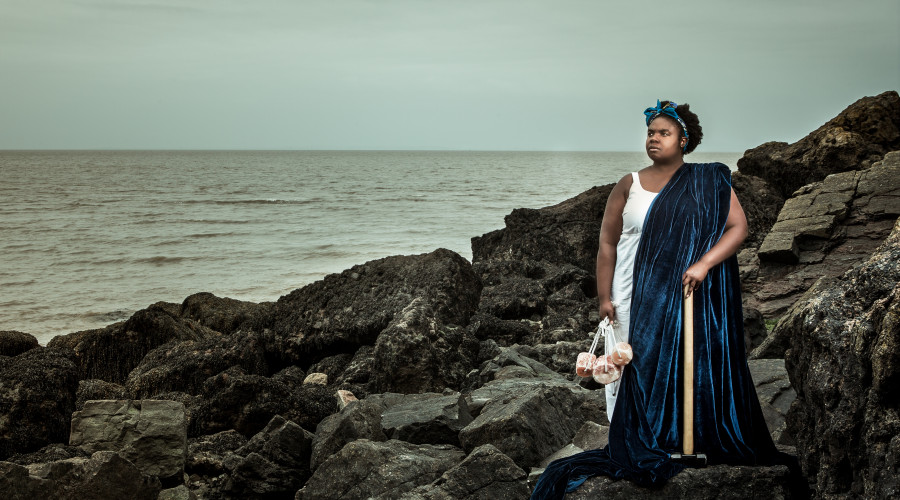
Also, I think you meet the audience when they see the publicity material: Chewing the Fat has a girl on all fours with a pink dressing gown in front of a fridge; Dark and Lovely is like this girl with a huge afro, laughing her head off; salt. is a woman stood on a really dark, ominous beach with a sledgehammer and rock salt and this massive blue veil flying out next to her. These are three very different publicity images! Publicity images are so important – your audience should have a sense of the exchange by the time they get to the theatre I think.
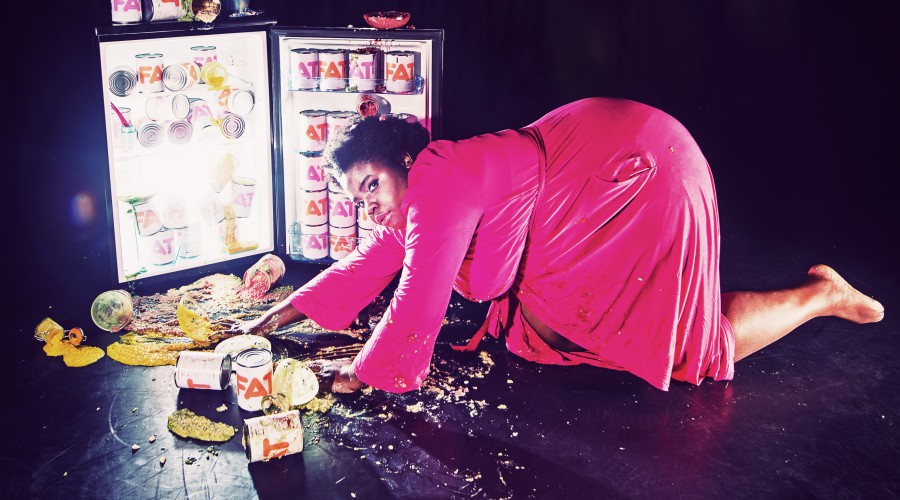
Diasporic time
PC: How do you structure your work?
ST: The first version of salt. was like: this is what happened to me and it was really unwieldy – two months of my life in an hour! I then spent some time working with Clare Duffy and we thought about what salt. looks like if we connect it up to the three act story structure. That was great because then what you get is a story that hits all these emotional points so that at the end the audience has catharsis – everybody claps and you all go home. But politically the hero’s journey is a really problematic story: it’s very male, masculine, western and linear.
PC: Does your experience of being a part of a diaspora influence how you tangle and disrupt the structure?
ST: Yeah, Chris Goode talks about ‘queer time’ – so rather than time as a straight line, it’s a circle and you bounce across the circle as and when you need to. That idea of queer time works really well for diasporic time – the idea that time doesn’t move forward and progress but accumulates, gathering around one fixed spot. That’s what being part of a diaspora feels like – it’s that sense of having a body that holds the slave trade, holds colonialism, holds the civil rights movement in America, holds Black Lives Matter, holds the New Cross fire that happened in London. There’s no catharsis for a story about the diaspora or a story about race because none of it’s finished, none of it’s resolved or dealt with, it’s just held. What you’re always negotiating is how you can hold it.
PC: How do the dramaturgs you have worked with support the process of disruption?
ST: Maddy Costa and Season Butler were my dramaturgs on salt. and there job was to disrupt at every turn what felt easy. I think that is what a dramaturg should do: disrupt. A really big thing that needed disrupting with salt. was there was loads of drama on the ship between myself and the filmmaker who came with me. That was really definitive in the first version and Season and Maddy really had to work with me to take that out of the work. I needed to acknowledge that that was of much more personal importance and not about the story that I was telling. Maddy was really good at making sure that salt. didn’t slip into travel writing – that it’s not a description of the journey that I went on but that it’s always analysis – it’s always making a political point. It is often just about cutting a lot of darlings.
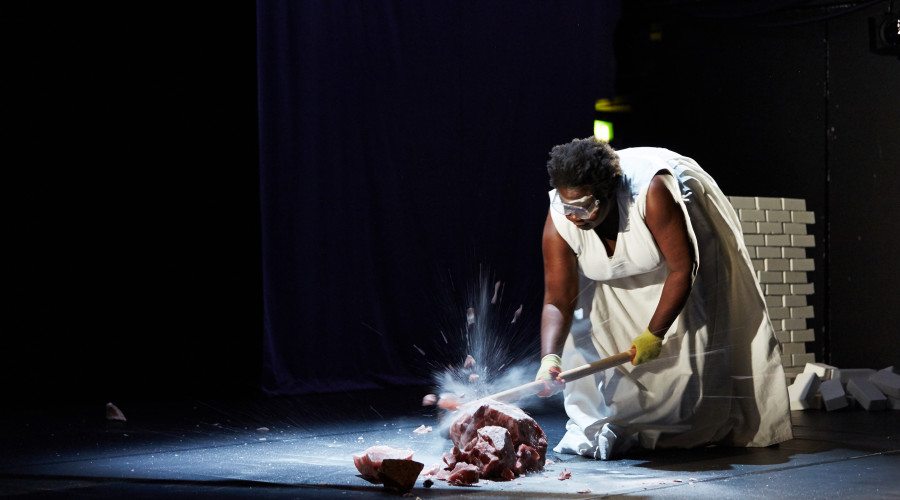
There for them
PC: How do you end shows in order to retain a care for your audience without letting them off the hook?
ST: At the end of Chewing the Fat there’s this kind of ritual cleaning with all of this stuff from lush so the space goes from being very abject to smelling like jasmine and lavender with soft lighting and Roberta Flack songs. Dark and Lovely ends with a fairy tale which is this kind of wish fulfilment – it’s very gentle.
salt. is a bit different, there are these three moments built into the structure where I tell little anecdotes of me on the phone to my dad talking about meeting teenagers, meeting French bulldogs, seeing a karate display and flirting with a Ghanaian boy. They’re silly and funny and when they happen there’s like a tiny bit of cello that warms up the space, the lights come up on the audience and I have a bit of water. They’re improvised so they have a really different tone of voice and they just take you out of it for a second.
At the end of salt., there’s a coda: the show, the ritual is finished but people can get a chunk of rock salt from me in the foyer. That felt really important to me because when I was younger I would go to a lot of theatre on my own and I’d be the only person of colour in the room; I’ve seen some really problematic work about race and been the only person of colour in the room. I have felt triggered and really hurt by that work and I haven’t been able to get out fast enough. So I wanted to make sure that if we ever had an audience where there was one or two young black people who were on their own and they needed a hug or to hold someone’s hand, I was there for that.
